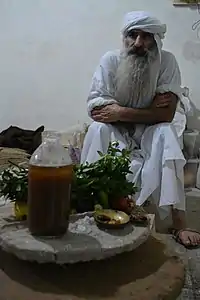Zidqa brika
In Mandaeism, the zidqa brika (or zidqa brikha; Classical Mandaic: ࡆࡉࡃࡒࡀ ࡁࡓࡉࡊࡀ, lit. 'blessed oblation') is a type of ritual meal blessed by Mandaean priests.[1][2] Zidqa means oblation and can also mean alms, while brika means blessed.[3]
| Part of a series on |
| Mandaeism |
|---|
 |
| Religion portal |
The zidqa brika is offered and eaten at the end of tarmida (junior priest) initiation ceremonies, after the novice's 60-day seclusion period.[1] It is also offered during the Parwanaya festival.[4]
It is distinct from the lofani and dukrana, which are two other types of ritual meal offered for the dead.[3]
Prayers
In E. S. Drower's version of the Qolasta, prayers 348-374 are for the zidqa brika. Prayers 375-381 are blessings recited after the zidqa brika.[5]
References
- Buckley, Jorunn Jacobsen (2002). The Mandaeans: ancient texts and modern people. New York: Oxford University Press. ISBN 0-19-515385-5. OCLC 65198443.
- Segelberg, Eric. 1977. "Zidqa Brika and the Mandæan Problem. In Proceedings of the International Colloquium on Gnosticism. Ed. Geo Widengren and David Hellholm. Stockholm.
- Drower, Ethel Stefana. 1937. The Mandaeans of Iraq and Iran. Oxford At The Clarendon Press.
- Burtea, Bogdan (2005). Das mandäische Fest der Schalttage: Edition, Übersetzung und Kommentierung der Handschrift (DC 24, Šarh ḏ-paruanaiia) (in German). Wiesbaden: Harrassowitz. ISBN 978-3-447-05179-8. OCLC 62273841.
- Drower, E. S. (1959). Canonical Prayerbook of the Mandaeans. Leiden: E.J. Brill.
This article is issued from Wikipedia. The text is licensed under Creative Commons - Attribution - Sharealike. Additional terms may apply for the media files.

